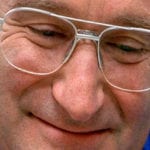 Miscellaneous
Miscellaneous  Miscellaneous
Miscellaneous  Our World
Our World 10 Green Practices That Actually Make a Difference
 Humans
Humans Ten Historic Men Who Deserve Way More Credit Than They Got
 Movies and TV
Movies and TV The 10 Most Heartwarming Moments in Pixar Films
 Travel
Travel Top 10 Religious Architectural Marvels
 Creepy
Creepy 10 Haunted Places in Alabama
 History
History Top 10 Tragic Facts about England’s 9 Days Queen
 Food
Food 10 Weird Foods Inspired by Your Favorite Movies
 Religion
Religion 10 Mind-Blowing Claims and Messages Hidden in the Bible Code
 Facts
Facts 10 Things You Never Knew about the History of Gambling
 Miscellaneous
Miscellaneous Ten Groundbreaking Tattoos with Fascinating Backstories
 Our World
Our World 10 Green Practices That Actually Make a Difference
 Humans
Humans Ten Historic Men Who Deserve Way More Credit Than They Got
Who's Behind Listverse?

Jamie Frater
Head Editor
Jamie founded Listverse due to an insatiable desire to share fascinating, obscure, and bizarre facts. He has been a guest speaker on numerous national radio and television stations and is a five time published author.
More About Us Movies and TV
Movies and TV The 10 Most Heartwarming Moments in Pixar Films
 Travel
Travel Top 10 Religious Architectural Marvels
 Creepy
Creepy 10 Haunted Places in Alabama
 History
History Top 10 Tragic Facts about England’s 9 Days Queen
 Food
Food 10 Weird Foods Inspired by Your Favorite Movies
 Religion
Religion 10 Mind-Blowing Claims and Messages Hidden in the Bible Code
 Facts
Facts 10 Things You Never Knew about the History of Gambling
10 Largely Forgotten Actors From Cinema’s Most Famous Scenes
Although names like Bogart, Brando, and Hoffman are forever etched in the minds of film lovers, names like Corsitto, Bedoya, and Welsh have largely been forgotten. It’s a travesty because these actors played critical roles in some of the most famous scenes in movie history.
10 Salvatore Corsitto
The Godfather
Before 1972, Salvatore Corsitto, a barber of Italian descent, had yet to appear in a film or television production. But things changed rapidly for Corsitto, who was chosen to play Italian undertaker Amerigo Bonasera in The Godfather after an open casting call by director Francis Ford Coppola.
In the film’s opening scene, Amerigo Bonasera asks the Godfather for a favor on the wedding day of the Godfather’s daughter. Bonasera wants justice for his own daughter, who was brutally beaten by two young men who escaped punishment in an American court of law.
Shortly after he was cast in the part, Corsitto found himself standing alone in the garden of Marlon Brando’s Mulholland Drive home, waiting for Coppola to summon him inside. After being invited in, Corsitto walked into the room and was introduced to Brando as one of the Don’s henchmen. Falling into character, the two actors ad-libbed a scene, delighting Coppola and launching Corsitto into film history.
His “I believe in America” monologue is one of the most memorable parts of the iconic film, and even Brando cited Corsitto’s performance as among the best in the movie.
9 Joe E. Brown
Some Like It Hot
Though big names like Cary Grant and Clark Gable are still remembered today for their contributions to comedy, most people have no idea who Joe E. Brown was. Before 1960, Brown was all the rage in vaudeville, Broadway, and film. Known for his giant mouth and million-dollar smile, Brown started his movie career in melodramas. But when directors and producers discovered his talent for making people laugh, Brown quickly moved to comedy, as shown in classics like A Midsummer Night’s Dream.
When Brown’s film career slowed, he spent most of his time on sports, visiting the troops during World War II, and stage work. Then in 1959, he was offered the role of millionaire Osgood Fielding III in one of the 20th century’s best comedies, Some Like it Hot.
Although the entire film is laugh-out-loud funny, the real kicker comes at the end when an enamored Brown proposes marriage to Jerry, played by Jack Lemmon, who is disguised as a woman. At first, Lemmon schemes to get a big divorce settlement out of Brown by revealing that Lemmon’s a man after they’ve married. But a friend convinces Lemmon that he can’t go through with the marriage.
Still in disguise, Lemmon tries to make Brown lose interest. But no matter what character flaw Lemmon claims to have, Brown still wants to get married. Finally, after Lemmon rips off his wig to reveal that he’s a man, Brown replies with the famous punch line: “Well, nobody’s perfect.”
Even some people who have never seen the film know about the scene, made perfect with Brown’s humorous face and smooth delivery. It is now among the American Film Institute’s top 50 quotes of all time.
8 Joe Mantell
Chinatown
Not many people know about this Oscar-nominated actor. In 1949, Joe Mantell made his film debut playing a newspaper boy in Undercover Man. He first received acclaim in 1956 with an Academy Award nomination for his supporting role as Angie, Ernest Borgnine’s best friend in the 1955 film Marty.
After that, Mantell was relegated to playing largely forgettable characters in movies and on television, although fans of 1960s sitcoms may remember him as the neighbor in Pete and Gladys and diehard Hitchcock fans may recall his minor role as a traveling salesman in The Birds.
However, a supporting role in the 1974 film noir Chinatown landed him a place in Hollywood history as partner Lawrence Walsh to private eye Jake Gittes, played by Jack Nicholson. In the bleak ending that sums up the impossibility of fighting powerful people who corrupt the system, Mantell utters the film’s most memorable line: “Forget it, Jake. It’s Chinatown.” This quote is now considered one of the best that cinema has to offer, landing in the American Film Institute’s top 100 quotes.
7 Pat Welsh
E.T.: The Extra-Terrestrial
Although you probably don’t realize it, Pat Welsh has made you laugh, cry, and feel every emotion in between.
The Marin County housewife was discovered in 1981 when Ben Burtt, the sound designer for George Lucas, overheard her talking to a clerk at a local camera store about enlarging some photos. Entranced, Burtt immediately took Welsh outside and explained that he was searching for a character voice for a new film. The fact that Welsh smoked two packs of cigarettes a day probably added to the unique sound of her voice.
Three months after auditioning, the 60-something Welsh beat out an 82-year-old Tibetan woman to become the voice of the lovable E.T. in the 1982 movie E.T.: The Extra-Terrestrial. Welsh earned a mere $380 for the 9.5-hour job.
So the next time you hear E.T. mutter the unforgettable words—“E.T. phone home”—you have a chain-smoking former elocution teacher to thank for it. Incidentally, her inimitable voice won her another voice role as the bounty hunter Boushh in Star Wars Episode VI: Return of the Jedi.
6 Estelle Reiner
When Harry Met Sally
Based on her name alone, not many people can recall the performances of Estelle Reiner, the matriarch of one of the preeminent families in American comedy. Yet she uttered one of the funniest lines in cinema history.
The wife of director/comedian/writer Carl Reiner and the mother of the equally talented Rob Reiner, Estelle started her career as a painter before segueing into acting. In 1943, she married Carl and became the inspiration for Mary Tyler Moore’s character in The Dick Van Dyke Show. However, her greatest work came in her sixties, when she became a notable cabaret singer and starred in several comedies.
The performance that etched her in the minds of cinemagoers came in her son Rob’s 1989 film, When Harry Met Sally. As a customer in a New York delicatessen, Estelle watches Meg Ryan fake a powerful, authentic-sounding orgasm and then tells the waitress: “I’ll have what she’s having.”
5 Alfonso Bedoya
The Treasure Of The Sierra Madre
Any lover of the classics can recite this famous line by heart, spoken confrontationally in a desert setting to the illustrious Humphrey Bogart: “Badges? We ain’t got no badges! We don’t need no badges. I don’t have to show you any stinkin’ badges!” The subject of dozens of parodies, it’s the line that defined Mexican actor Alfonso Bedoya’s career.
Born in 1904, Bedoya first worked as a character actor in the Mexican film industry, although he had been educated in Houston as a teenager. But the life of this weathered, menacing-looking actor changed forever in 1948 when he was cast as the bandit Gold Hat in John Huston’s The Treasure of the Sierra Madre, now considered to be one of the greatest films of all time. Though Bedoya continued to win roles in other movies, none matched the power of his American debut.
Unfortunately, alcoholism shortened his life, leaving the character of Ramon Guiteras in 1958’s The Big Country as his last important role.
4 Margaret Hamilton
The Wizard Of Oz
Despite a career in film, television, radio, and theater that spanned about 50 years, most of us find it hard to remember this gentle, talented actress in any role other than the one she played in the film version of a children’s story.
Margaret Hamilton originally worked as a kindergarten teacher before her debut in Another Language, the first of over 70 movie roles in her long career. Although she usually played unpleasant characters, none matched her bone-chilling, fear-inspiring performance in 1939’s The Wizard of Oz as the Wicked Witch of the West.
That role gained her the most notoriety, with her angular facial features, bent frame, screeching cackle, and frightening scowl both terrifying and delighting children for generations. Although she worried about her character’s impact on kids and found herself relentlessly informing them that it was make-believe, we can’t help but love her delivery of unforgettable lines like the haunting: “I’ll get you, my pretty, and your little dog, too!”
3 Pat O’Brien
Knute Rockne: All American
Although Pat O’Brien made over 100 films in six decades of acting, his greatest acting triumph (and probably his only chance of being known by modern audiences) is as the titular character in 1941’s Knute Rockne: All American. “He immortalized a movie role as perhaps no other actor in the history of filmmaking when he portrayed our legendary Knute Rockne,” said Notre Dame president Theodore M. Hesburgh to the Observer-Reporter in 1983 when O’Brien died. “We will always consider him a part of the Notre Dame family.”
Known for his tough guy roles, O’Brien was a part of the “Irish Mafia” group of actors (the Brat Pack of the 1930s) that included James Cagney, Frank McHugh, and Spencer Tracy. But O’Brien knew how to melt hearts as well, making both genders cry with his emotional monologue as the famous Notre Dame football coach:
Boys, I’m going to tell you something that I’ve kept to myself for years. None of you here ever knew George Gipp. It was long before your time. But you all do know what his tradition stands for at Notre Dame. Well, the last thing he said to me was . . . “Rock, sometime when the team is up against it, when things are wrong, and the breaks are beating the boys . . . tell ’em to go in there with all they’ve got and win just one for the Gipper . . . I don’t know where I’ll be then, Rock,” he said, “but I’ll know about it . . . and I’ll be happy.”
2 Brandon De Wilde
Shane
When Brandon De Wilde was seven years old, his father, a stage manager for the Broadway play Member of the Wedding, was asked by the casting director to audition his son for a role in the play. De Wilde won the part, ultimately giving almost 500 performances and becoming the first child actor to win the Donaldson Award for the “Best Performance Debut” of the year.
After seeing De Wilde in that play, producer George Stevens cast him as nine-year-old Joey Starrett in Shane, a 1953 western starring Alan Ladd that the American Film Institute considers to be among the best films ever made. De Wilde was nominated for an Academy Award for Best Supporting Actor for his performance in Shane.
He captured the hearts of his audience as the naive little boy that became enchanted with the mysterious gunslinger, Shane. De Wilde’s performance was especially memorable in the ending scene where he calls repeatedly to the receding lone figure of the cowboy. Unfortunately, the career of the handsome De Wilde was cut short when he was killed in a tragic car accident in 1972 at age 30.
1 Colin Clive
Frankenstein
Born in France in 1900 as the son of a British colonel, Colin Clive had his life changed forever by an injured knee. Excused from military service, he decided to embark on an acting career, becoming one of the in-demand romantic leads of the 1930s who was paired with iconic actresses such as Katharine Hepburn, Bette Davis, and Jean Arthur.
Despite those roles, he is most remembered for his performance as the deranged Dr. Henry Frankenstein, the mad scientist who created the monster in the horror film classic, Frankenstein. Clive only made three horror movies, but he is often considered to be a top star in the genre. His interpretation of the mad scientist character inspired countless actors, horror films, and spoof movies. Even those who have never seen Frankenstein can picture the epic feel of the film’s unforgettable “It’s alive!” scene.
Unfortunately, Clive suffered from alcoholism, which often interfered with his performances on the set. He also became infected with tuberculosis, with complications from the disease leading to his untimely death in 1937 at age 37.

![Top 10 Most Important Nude Scenes In Movie History [Videos] Top 10 Most Important Nude Scenes In Movie History [Videos]](https://listverse.com/wp-content/uploads/2019/09/sharonstone-150x150.jpg)






